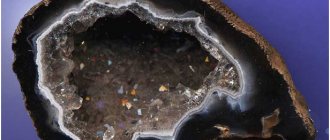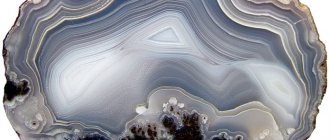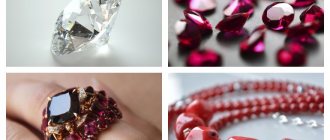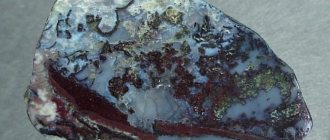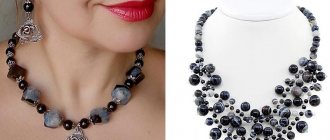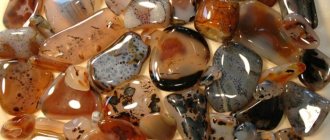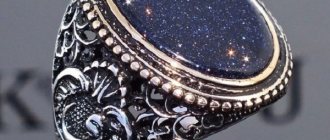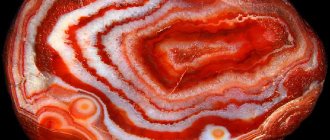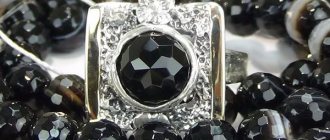Exquisite beauty, bewitching, unique patterns - this is natural agate, a semi-precious mineral. It is not surprising that gemstones are increasingly being counterfeited, “improved” - tinted, painted, irradiated. This destroys the magical and healing properties of natural stone. How to distinguish natural agate from imitation can be found in this article.
Natural agate
HOW TO DISTINGUISH A GENUINE AGATE FROM A FAKE
Real agate or fake can be determined in different ways. There are instrumental methods that are not available to the average buyer. These include:
- Chelsea filter. Under it, blue and green agates will glow with a pinkish light.
- Fluorescence color: pale, yellowish, greenish. Agate practically does not fluoresce; if the stone being analyzed cheerfully and actively fluoresces in other colors, then it is a fake.
- Examination of the sample under a microscope. Here, almost all the secrets of the fakes are in full view. The mineral is not monolithic; it has cracks and voids. And the coloring solutions that fill cracks are clearly visible under a microscope.
Sarder
If you don’t have a microscope and fluorometer in your bag, you can use your eyes, hands and knowledge from our article.
Thermal conductivity
Natural minerals have low thermal conductivity.
- A fake made of epoxy resins, plastic or glass will heat up very quickly in the palm of your hand, within 5-7 seconds.
- A natural gem will require at least half a minute to heat up.
Hardness
The strength test will help in identifying fake stone chips.
You can take a sewing needle and scratch the gem.
This method works especially well when checking a bead, where you need to “poke” with a needle next to the hole in the bead.
- The mass pressed from crumbs will crumble when pressed or scratched.
- Natural agate will withstand “attack”.
Chrysoprase
Color fastness
Painted stones are brought to clean water... with water.
- Dip the gem halfway into the water.
- Let him stay there for several hours.
- During this time, the water will wash away the paint that was used to tint the gem.
- If it has been painted, the water will become slightly cloudy after a few hours.
We study the difference between the dry and soaked parts of the stone.
On suspicion:
- difference in color of the parts being tested;
- the shine of the “soaked” half - natural agate will not change its shine;
- The color of the stone has faded or become cloudy - this means that you are holding a fake.
The natural gem, after drying, will be the same as before testing.
Sapphirine
Shine
The natural mineral has a soft matte shine.
In your hand, the glassy shine of the stone pleases the eye - don’t be fooled, this is not an agate, but a tinted gem, “killed” by treatment with chemically aggressive solutions.
Color
Often, ordinary natural gray stones are impregnated with solutions of salts of chromium, cobalt, iron, nickel and other metals. The process is combined with annealing or treatment with acids or alkalis.
| Expected color | What and how to process |
| Blue (cyan) | The mineral is placed in a solution of yellow blood salt, then boiled in a solution of iron sulfate. |
| Black | The gem is kept in a concentrated sugar solution, then treated with sulfuric acid. Cobalt nitrate is sometimes used. |
| Brown (imitation sarder) | Methods for obtaining black stone vary. |
| Green | Impregnation of the mineral with solutions of chromium salts or nickel nitrate followed by firing. |
| Red | The gem is treated with a solution of iron nitrate and then fired. |
African agate
(firing - high heat).
To enhance color, natural stone is subjected to ionizing radiation.
If:
- layers are too contrasting, sharp transitions between stripes;
- solid color, without stripes or lines (even subtle ones);
- too bright, unnatural colors -
It is better to refuse the purchase - this is clearly processed agate that has lost its healing and magical properties; it cannot be called natural.
Cracks
“African agate”, “dragon veins”, “craquele” are not varieties of gemstones. The names are derived from the processing method.
- Natural agate is tinted (painted), then heated strongly and immediately cooled sharply. This causes dark cracks that look like veins to appear in the stone. These varieties are called "craquele", or "dragon veins".
- Natural craquel exists, but is vanishingly rare.
- If the gem is first heated and cooled, and then painted, the veins remain light, but the stone darkens. This is an “African” agate, no longer a natural specimen.
Black agate ring
Uniformity
- A natural mineral always contains layers, even if they are invisible to the naked eye.
- Even in a black specimen (if it is natural), reddish, gray, and white layers are visible under a magnifying glass. It is impossible to fake them.
Agate is a layered stone: this is its “calling card”.
Certificates
- There are no state-issued certificates for semi-precious stones.
- There are organizations that can issue a so-called certificate (according to their own standards). Naturally, without an expert opinion, this is just a piece of paper.
- All that can legally support the naturalness and properties of a stone is an expert opinion from a gemological laboratory. However, you will have to pay for it. Often more than the stone itself is worth.
Varieties and colors
It is impossible to clearly state what color an agate is. This mineral has many faces, like nature itself: there are white-brown, white-blue, yellow, pink, even black and bright blue varieties. Moreover, many common subspecies have their own names, such as onyx, sardonyx and sapphirine.
Agate jewelry
A specific variety of agate is determined by the pattern on the saw blade and the combination of colors. Primary colors:
- brown;
- blue or blue;
- yellow-brown;
- pink;
- grey;
- greenish;
- shades of red or carmine.
Black agate is less common.
A rare blue variety is called sapphirine.
Sapphirine stones
In addition to the variety of colors, agates are classified according to the pattern on the fracture or cut. Interspersed with various elements can form figures there that resemble natural landscapes, city outlines, ruins of fortresses, tree branches or imprints of ancient petrified moss. Some stones when cut resemble the shells of prehistoric fossilized mollusks, and sometimes fossil cephalopods actually turn out to be part of the agate.
The classification by type speaks for itself:
- star;
- banded;
- landscape or landscape;
- bastion or ruin;
- flywheel;
- dendrite;
- floral;
- frosty;
- disk;
- iridescent;
- fiery;
- rainbow.
Separately, it is worth noting flywheel, dendrite and flower agate. The first has an amazing pattern, reminiscent of black northern moss on a light background. On the cut of the second one you can see a picture that suggests dense forest thickets. Floral - something between the first and second; on the cut of such a specimen you can see a fancy flower.
This list is far from complete. Each deposit is distinguished by its own “signature” stone pattern. Green ones with a brown pattern, for example, are mined in India, black and white striped ones are found in the mountains of Tibet, and specimens with “pupils” of alternating brown, white and gray stripes are brought from Brazil.
PROPERTIES
Agate in section
Hardness 6.5-7. The shine on a fracture is dull, greasy or matte, on a polished surface it is glassy. In terms of chemical composition, like quartz, it is silica, but of a heterogeneous structure and with a large number of impurities. Resistant to acids, etching only in HF. Durable and tough. Opaque, translucent at the edges. In most agates, layers of chalcedony proper and its structural variety - quartzine (lutecine), differ from chalcedony in the direction of fiber elongation; in chalcedony it is perpendicular to the “C” axis (the direction of elongation of quartz crystals), and in quartzine it is parallel to it or with a deviation of 30° (lutecin). Visually, quartzin layers are usually distinguished by a milky white color.
The color is very diverse, usually alternating blue-gray and white layers predominate. If layers of yellow, red, brown, black or another color alternate with white layers, then this variety may have its own name.
Description of the mineral
Agate is distinguished by a wide variety of colors and types, but among their abundance there is still a pattern. All agates are characterized by elegant banding, formed by stripes of varying widths (from 1 mm to several centimeters), smooth color transitions and rich brightness of colors.
Agate was formed in mountain lavas by the accretion of various minerals of the silica family, the main of which is chalcedony, which has a layered structure. That is why agate is characterized by pronounced layers, which can vary in color and degree of transparency. When cut, the stone has an original, never repeating pattern. The density of the stone is 6.7 - 7.0 units on the Mohs scale. After polishing, the stone acquires a glassy glossy surface, but when cut it is more matte and greasy.
History and origin
Agate is a stone of volcanic origin. It is believed that it was first found on the island of Sicily, near the Achates River. The name of the stone was given to the place where it was discovered. Although another version of the legend claims that the mineral got its name from the Greek “agathos” - kind, happy.
Agate stone
By nature, it is a type of chalcedony, which in turn is a type of quartz. Description: Alternating layers of contrasting colors, objects in the form of ellipses and stars, mosaic or kaleidoscopic images reminiscent of the ruins of ancient cities, and even misty figures reminiscent of plants are all agate. But ironically, the true beauty of a stone can only be seen through its cut or fracture. Outwardly, it is a completely unremarkable pebble.
The amazing internal coloring, inexplicable from the point of view of the ancients, gave rise to an abundance of legends and rumors associated with this stone.
The importance of agate was so great that products made from it - dishes, bowls, figurines - with proper craftsmanship were considered worthy of decorating the chambers of emperors. It is known that agate was valued in the courts of at least two European rulers - the Basileus of Byzantium and, a couple of centuries later, the Austrian Habsburg dynasty. The characteristics of the stone allow for very fine processing, achieving a strong artistic effect, therefore in ancient times it was classified not as an ornamental stone, but as a precious stone.
History and origin
Agate is a stone of volcanic origin. It is believed that it was first found on the island of Sicily, near the Achates River. The name of the stone was given to the place where it was discovered. Although another version of the legend claims that the mineral got its name from the Greek “agathos” - kind, happy.
Agate stone
By nature, it is a type of chalcedony, which in turn is a type of quartz. Description: Alternating layers of contrasting colors, objects in the form of ellipses and stars, mosaic or kaleidoscopic images reminiscent of the ruins of ancient cities, and even misty figures reminiscent of plants are all agate. But ironically, the true beauty of a stone can only be seen through its cut or fracture. Outwardly, it is a completely unremarkable pebble.
The amazing internal coloring, inexplicable from the point of view of the ancients, gave rise to an abundance of legends and rumors associated with this stone.
The importance of agate was so great that products made from it - dishes, bowls, figurines - with proper craftsmanship were considered worthy of decorating the chambers of emperors. It is known that agate was valued in the courts of at least two European rulers - the Basileus of Byzantium and, a couple of centuries later, the Austrian Habsburg dynasty. The characteristics of the stone allow for very fine processing, achieving a strong artistic effect, therefore in ancient times it was classified not as an ornamental stone, but as a precious stone.
Physicochemical characteristics
By chemical nature it is silica, silicon dioxide. Certain varieties of agate include inclusions of other elements of the periodic table, primarily carbonates, fluorides and sulfides, and less commonly metals.
Agate stone
This is a polymineral consisting of separate layers of chalcedony, quartz derivatives and other substances. A distinctive feature of agate is that the boundaries between the layers are very clearly visible, while the heterogeneity of the structure does not affect the strength characteristics of the stone. Mohs hardness 6.5–7, matte gloss. Some specimens are distinguished by translucent edges.
| Formula | SiO2 |
| Color | White, grey, blue, yellow, red, black. |
| Shine | Matte |
| Transparency | Transparent, translucent. |
| Hardness | 7 |
| Cleavage | Missing |
| Kink | Uneven, conchoidal. |
| Density | 2.6 g/cm³ |

